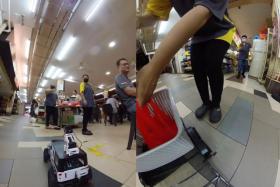Deepfake videos the new weapon in fake news
Deepfake videos have potential to cause chaos, transforming election interference and geopolitics
The election interference tactics originally deployed by Russia against the US and Europe are now global.
Hackers across the world have exploited weaknesses in e-mail servers, probed voting machines for vulnerabilities, set up troll farms to spread partisan narratives, and employed bots to distort the truth.
Tech experts in countries such as Iran and Venezuela have borrowed these tactics and joined efforts toward the same goals: to erode confidence in electoral processes and in democratic governance itself.
Monitoring by social media companies seems to have blunted some of the disinformation campaign ahead of the Nov 6 midterm election in the US.
But these tactics are just the start. There will be a far more dangerous interference tool: deepfake videos.
Deepfake technology will enable users anywhere to fabricate videos of virtually anyone, doing and saying anything.
With artificial intelligence (AI), the technology allows users to superimpose images on to videos, and even allowing them to make facial and voice manipulations convincing.
Currently, creating a credible deepfake video is not easy, and only a few countries have the advanced technology and specialists capable of using it.
However, video and audio manipulation technology are progressing, becoming easier to use and giving less tech-savvy actors access to deepfake tools.
By the next US presidential election, these tools will likely have become so widespread that anyone with a little technical knowledge will be able to make a video of any person, doing and saying whatever they want.
Deepfake videos have the potential to do great harm.
They can be fabricated to show candidates making inflammatory statements or looking inept, and civic discourse will further degrade and public trust will plummet.
Deepfake technology could take a bogus conspiracy theory and make it appear more credible, confusing the media and voters and sowing further discord.
Deepfakes could transform not just election interference, but politics and geopolitics.
There are measures that everyone who cares about democracy should take to prepare for this next wave of disinformation and election interference.
First, we must use AI to identify and stop deepfake videos before they spread. AI can use machine learning classifiers to sniff out imperfections in manipulated video.
Governments and tech companies need to work together to develop this technology and make it widely available.
Second, social media and digital information companies should use research and development before the threat spirals out of control on their platforms.
All social media platforms should embrace this challenge and treat it as a shared public interest priority.
Facebook recently built a machine-learning model to detect potentially fake material, which it sends to fact-checkers.
But even such action will not be enough.
Everyone working on election integrity has a responsibility to educate the public about these videos.
Developing detection technology and educating the public must be priorities if we hope to face down this threat to democracy. - REUTERS
Mr Michael Chertoff was US secretary of homeland security from 2005 to 2009. Ms Eileen Donahoe is executive director at the Global Digital Policy Incubator at the Stanford Centre for Democracy, Development and the Rule of Law.
Get The New Paper on your phone with the free TNP app. Download from the Apple App Store or Google Play Store now


